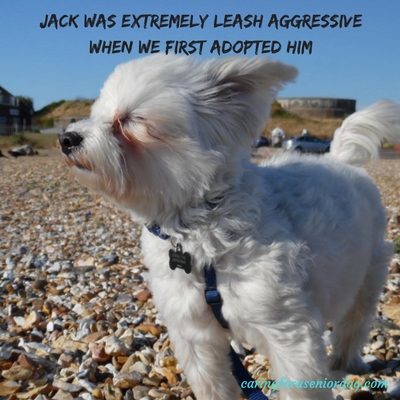
As a dog trainer of course I’ve helped many people with leash aggression training, but when we adopted Jack he came with one of the most severe cases of leash aggression I had seen.
You may be wondering why a topic such as this, is appearing on a senior dog site? Well, if people could get over the attitude of senior dogs being close to death, they’d realise dogs of any age can be in need of training.
First things first!
Has your dog always been great on a leash, but as he’s getting older he’s becoming aggressive?
Have you recently adopted a senior dog, with a past that is unknown?
Perhaps, like us, you adopted a dog who was mistreated and is now insecure and/or fearful.
Consider these possible causes:
- vision and/or hearing impairment leading to your dog feeling anxious or insecure
- canine cognitive disorder (doggie dementia) causing confusion, not recognising familiar places
- arthritis or other illness causing him pain
- abuse in his past
- lack of training
What’s the second step?
When dealing with changes in behaviour or a new member joining your family, my usual recommendation applies. Get down to your wonderfully helpful vet for a health check to make sure everything is fine.
The results are in…
I can’t possibly know what your vet found or didn’t find, but many of the suggestions listed below can still be applicable. 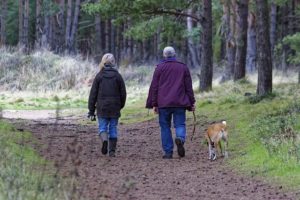 If it turns out they aren’t…
If it turns out they aren’t…
…perhaps the best solution in your case is to do what my neighbour does. He has a lovely old dog named Sasha. She has vision and hearing loss, and I wouldn’t be surprised if she suffered from some degree of dementia as well. Because of all that, the poor baby freaks out when anyone is around. What’s the point in constantly subjecting her to busy streets, and lots of “targets.” He now just walks her around the immediate area, away from foot traffic, and she’s doing great. It’s the kind thing to do for her, she remains calm, and still gets her outings.
Back to the article!!
For those who’ve had their dogs from the beginning and whose past is no secret, or your incredibly helpful training has given him a new lease on life, reasons can include:
the walker giving unintentional signals to be aggressive
bad experiences with other dogs caused fear or dislike
lack of socialisation
loves to play so much he gets frustrated being held back
When this behaviour starts, the walker will instinctively tighten up on the leash, to hold the dog back. This creates 2 problems – 1) the walker becomes on edge each time they’re out, transferring that tension to the dog and teaching him there is something to fear and 2) tightening up on the leash is exactly what you do in attack training – meaning they’re unintentionally training the dog to attack.
Off leash dogs in a dog park tend to approach each other in an arc, not head on. They sniff, then decide whether to hang out, or move on. That’s in real contrast to dogs out for a walk on a leash, who approach each other head on, looking at each other, not being able to turn their bodies, all of which in doggie language is threatening, and looking for a fight.
This is intensified when the walkers stop to chat, keeping the dogs in this state longer and longer. As the dogs strain against their leashes, guardians are tightening them, holding the dogs back, adding to the problem by confirming for the dogs there is a reason to feel threatened.
Dogs sense the change in our behaviour and body language, feeling the tension all the way through the leash. Now not only are you on edge, but so is the dog, creating a vicious cycle that will never end.
A quick note – don’t blame your dog if irresponsible owners allow their off leash dogs (or even on leash) to get in your dog’s face, jump on them… It’s considered rude doggie behaviour, and your dog is responding appropriately.
Here is a starting point
Never, ever punish your dog for barking.
He needs to pay attention to you, so practice in a quiet environment at home. Call his name in a calm voice, and when he looks at you, reward him. Try it in increasingly busy areas, as that’s the challenge.
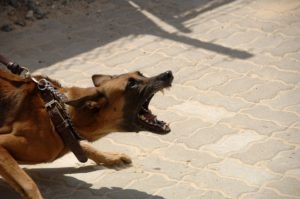 Pay attention to your dog’s body language, noticing what changes occur when he starts to get aggressive. If you intervene at the hint of a first sign, you’ll have better luck preventing full out aggression, and getting him to respond to your commands.
Pay attention to your dog’s body language, noticing what changes occur when he starts to get aggressive. If you intervene at the hint of a first sign, you’ll have better luck preventing full out aggression, and getting him to respond to your commands.
If your dog goes full out aggressive, he won’t listen to you so forget it, just remove him from the situation as quickly as possible.
Your own state is equally important. Don’t hold your breath or have rigid posture – be casual, be cool.
Always keep the leash loose, no tension, but be sure to have a firm enough grip, in case you have to pull him back quickly.
Tire him out a little before your walk, by playing with him for a few minutes. A tired dog may be less reactive.
If you have a small dog that can easily be picked up, cover his face so he doesn’t see approaching dogs. Don’t do this as a matter of course, just if you don’t feel in control of the situation.
Cross the road, or turn around.
If a dog is approaching head on, try and make a large arc around him, keeping calm and not saying a word. Of course reward your dog (only if he was “good”) until they’re out of sight of each other.
Stick to the quieter areas, where encountering others is less likely.
Change your dog walking times to when you know there’s fewer chances of meeting other dogs and/or people.
Is this really the solution?
Of course the avoidance techniques are just band aids, and won’t help him get over the aggression. You’re also denying a social creature the opportunity to interact with people and others of his kind, which really isn’t fair.
Having said that, if you’re feeling lazy (which we all do at times), or aren’t yet confident that you can change things (which you can!!), minimizing the amount of contact may be a good way to start the training, since you won’t be bombarded by “threats” all at once.
Create real change using desensitisation
The best way to help is to teach him that great things happen when he meets other dogs and people. It’s about redirecting his attention to you, and giving him favourite treats until the “threat” has passed.
Save the good stuff for this training, so he’ll be even more motivated. Chicken, turkey or even vegetables are good, if your dog is allowed them as part of his diet. Keep the pieces small, and watch his weight.
I recommend buying a treat pouch, to keep your treats handy. There’s a clip that allows it to be easily attached to a pocket, belt or waist band.
The desensitisation technique
There’s a range within which dogs are perfectly fine, but closer than that, on leash dog aggression starts. Do you know at what distance your dog starts to growl/bark/lunge?
For practice, recruit someone you know with a very calm dog. Start off with them in that safe range, and walk towards each other. While still in that safe zone, ask your dog to sit or call his name, get him to focus only on you, and start giving him the treats, praising him the whole time.
Keep giving him treats only until your friend and dog have walked by you and are no longer in view, then stop. Don’t say anything, or look at him, just carry on with your walk. You want him to know nothing happened, no big deal. Repeat this exercise every few minutes, but don’t go on too long, then try again the next day.
A quick note – when passing each other you need to be several feet apart.
Each day that you try this exercise, have your friend and dog get a little closer. Depending on how reactive your dog is, you may make very slow progress, but that’s okay. If he barks or lunges, you’ve gone too fast. Rushing it could cause setbacks, and you’ll be worse off than before you started.
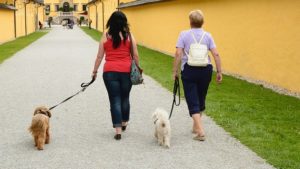 If you don’t have a friend to practice with, go to an area where you know people walk their dogs, but go when it’s a quiet time so he’s not bombarded all at once. Remember to keep distance between yourself and other dogs, but allow them to be within your dog’s sight.
If you don’t have a friend to practice with, go to an area where you know people walk their dogs, but go when it’s a quiet time so he’s not bombarded all at once. Remember to keep distance between yourself and other dogs, but allow them to be within your dog’s sight.
If you’re feeling unsure, or someone comes up suddenly, stay calm, change directions, then try again with the next dog. It takes practice to get the timing right, so don’t be too hard on yourself.
You could also try sitting on a bench with him if that would make you more comfortable to start with, and do the same things with the treats. I’d start with a bench in a quieter area, so he doesn’t have to deal with a steady flow of people and their dogs.
You’ll find people will want to come up to you, please warn them off before they get too close and your dog starts to bark. That sets his training back, and causes him unneeded stress.
My experience
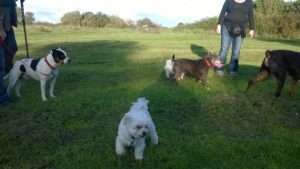 My husband and I adopted a dog a couple of years ago, who we called Jack. Not very original to be sure, but seems to suit him. Anyway, it’s pretty obvious he was abused and was worse than a nightmare on a leash. If he saw a dog, or a person in the distance (and I mean very far distance) he would literally go ballistic.
My husband and I adopted a dog a couple of years ago, who we called Jack. Not very original to be sure, but seems to suit him. Anyway, it’s pretty obvious he was abused and was worse than a nightmare on a leash. If he saw a dog, or a person in the distance (and I mean very far distance) he would literally go ballistic.
I talked earlier about having someone with a calm dog help, but I didn’t have that. I followed the rest of the advice about walking when it’s quieter, making him sit and look at me as someone approached, giving delicious treats…. It took a long time, and it’s still ongoing because he had severe issues, but he is like a different dog thanks to this process. I still bring treats just in case, but he’s doing great.
On leash dog aggression – conclusion
Desensitisation does work (as long as his aggression does not stem from any of the health issues I mentioned) but you do need patience, consistency, perseverance and the desire to help.
It takes lots of practice to get the timing right, so don’t be too hard on yourself. If you’re not feeling confident, you can stick to quieter areas until you get the hang of it.
If something wasn’t clear, or you have questions, please contact me through the contact page, or the comment section below, and I will be more than happy to help with your on leash dog aggression issues.

 Separation Anxiety in Older Dogs
Separation Anxiety in Older Dogs
It is difficult to walk down the street and see a dog coming your way as you don’t know the dog and whether it is going to “lash out”. I certainly have gained value from your explanations and the easy to read style you write with.
I don’t own a dog so your advice on training, handling etc are of no value to me BUT I believe everyone should know enough to be able to “read” a dog as it comes toward them, if you can’t cross the road or hope that the owner protects you and the dog.
Thanks for your advice.
Hi Steve, thanks for your comment. I’m guessing you haven’t shared your life with dogs before, since you seem to expect every dog may decide to lash out at you! Of course you have plenty of irresponsible pet parents out there, as well as many who are clueless, but I hope you don’t fear every dog you pass, otherwise you’d be missing out on some fun times!! I hope you’ll share this content with others you know who may benefit.
Another wonderful and informative post, Hindy. There are so many unadopted animals in the world now, and finding the right home for older animals is especially difficult. Once the initial step of bringing an adopted pet into your home, the real work begins. It is a difficult adjusment for the owner as well as the animal, but there is nothing quite as satisfying as showing the love and care that he had been missing.
Thank you Morgan, and you are too right! An unacceptable number of homeless animals, and too many people not interested in senior dogs which is a shame. Bringing any new pet, no matter the type or age, into your home is stressful and an adjustment for everyone. It takes some time, but eventually you get the schedule sorted, a routine going and you start to enjoy the amazing animal you share your home with, whose life you saved. You can’t beat that feeling.
hi Hindy
Wonderful and informative article about on leash dog aggression! I like that you say never punish a dog for barking. Which I agree with as it is a natural reaction for the dog. And yes it makes so much sense that pulling on the leash would make things worse as it would only make the dog be on high alert! You also describe the desensitisation technique very well. As a therapist, it reminds me of exposure therapy. Where the person is gradually exposed to something or a situation that causes anxiety or fear or aggression. Well any strong emotion that interferes with one’s functioning. Same with the dog.
Hi Emily, there is never a reason to punish a dog. The fact that humans aren’t training them properly is not their fault, and they should never suffer as a result. Exposure therapy does sound like desensitisation. I see how much my dog Jack has changed using that technique, and I want to go over to people who obviously need help and offer them a solution, but they don’t ever seem to want to hear it. Shame!
That was a great post. Man you know your stuff. So of course I have a question. I don’t have an aggressive dog but when I walk him he pulls. He walks me instead of the other way around. How do I teach him not to pull? Second, I purposely walk in the middle of the street so there’s nothing for him to stop and smell. Any suggestions? Thanks.
That’s very kind of you to say Rawl. First of all, why not let him stop and smell? That’s what dogs do – he wants to check out what’s going on in his neighbourhood. My other dog Jack will sniff every blade of grass if I let him, so what I do is I let him sniff for a bit, then I walk him towards the middle, or just pick up the pace, then I let him sniff. As far as your dog walking you goes…There are 2 things you can do, but you need lots of patience, and whoever else walks your dog has to do exactly the same thing as you; consistency otherwise your dog will get confused. First of all, don’t know what kind of leash you use, but if it’s a flexi put it away (I’m actually writing a post about that shortly!). Use a regular 4′ or 6′ leash, although you may have to wrap it around your hand, because you want him walking next to you. Also, again, not sure what you do, but it’s best to pick a side and keep your dog walking on that side – no running from side to side, tripping everyone. I only walk on the left, but that’s my preference. Try and practice all these tips when it’s quiet, so he’s not distracted and wanting to say hi to everyone.
One method – every single time you take a step and he pulls, stop. I mean every single time. As soon as he starts getting ahead of you, stop. Do not move until the leash goes slack. This is a real lesson in patience. Take another step, he pulls, you stop. You could literally take 1/2 hour to get to the corner. By the way, you could practice this, and the next method, in the house or the yard.
The second method also requires patience and commitment, but you may find it a bit easier because at least you’re constantly moving. Start off on your walk, as soon as he starts to pull ahead of you, say “let’s go” or pick a word you prefer, then turn around and walk in the opposite direction. Do that for just a few steps, then say “let’s go” again and turn back and head in your original direction. He pulls, you do it again. Every single time he starts to pull you do that. The point is – he’s on a mission to get somewhere, but he will learn that he’s not getting there, he’s actually going backwards, as long as he pulls. I used this technique on a couple of dogs I was babysitting, and they literally got the hang of it in 2 days. No they weren’t perfect right away, but they were heaps better.
Any other questions, contact me I’m always happy to help you.
Hi Hindy,
thanks for sharing this fantastic post on how to handle on leash dog aggression.
When I have gone on hikes on Ramapo Reservation I often see walkers with their dogs, some dogs would bark and others do not but just come up to sniff and say hello. Some dogs will bark, but is that a bad thing? I thought barking was a way for the dog to communicate how they feel, like if they are threatened or something. Is barking an aggressive behavior then?
I think I will use the desensitization method when I need it. I think it would be best to practice in a quiet area first and doing it slowly so your dog does not get confused.
Hi Dinh, it isn’t barking that’s “bad” – it’s the way dogs communicate, and every bark is not an aggressive one. If it’s your dog, then I’m going to assume you know your dog well enough to understand what he’s trying to communicate. If you come across unfamiliar dogs, it’s best not to put your hand out to pet him, but rather ask the person if the dog is friendly, or just ignore the dog if you want to be sure. Desensitisation really is a wonderful method, and has significantly helped my dog Jack cope with a variety of situations. Quiet areas mean less distractions, so he is better able to pay attention.